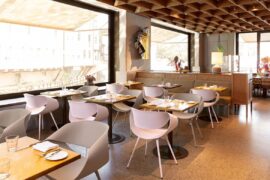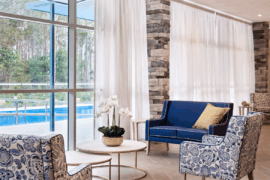A recent trip to Ofitec, Madrid, produced opportunities to see many exciting developments in the bustling city. Special report by Alaana Fitzpatrick, editor of Design Quarterly Magazine.
March 26th, 2008
The capital of Spain certainly lived up to expectations on a recent visit. The people – as always – were welcoming and lively, and the sites and scenes whet my appetite for design.
I took a tour of the Hotel Puerto America, which I’ve seen to death in print, but was still excited to venture within. It’s a colourful monstrosity of a façade, just off the highway, but inside I was quite awestruck by the eclectic and evocative spaces that were created.
Although only allowed into a handful of the rooms, we certainly were shown some of the highlights, including Zaha Hadid’s organic melding rooms, Plasma’s metallic prism walkways with crisply geometric rooms and Ron Arad’s circular compulsions.
I was also fortunate enough to be guided through the extension of the Museo del Prado completed in 2007, designed by revered architect, Rafael Moneo.
The sensitive treatment of the development has allowed the museum more room for visitor services and temporary exhibitions as well as freeing up the main halls of the original building. The finishes are meticulous, with Madrid granite, oak, cedar and bronze interwoven and highlighted with natural light that pierces deep into the museum.
Ofitec was also well worth the hours spent in transit – even with delays and the temporary loss of luggage! It’s a very manageably sized fair that didn’t try to be too many things to too many people and focused solely on commercial interiors (with an emphasis on Spanish content).
Throughout the visit, a few names were brought to my attention – Tramo, Shetug, Iduna, Hodema and Portuguese company FAMO – and the usual suspects demanded keen attention too – Sellex, Enea, Akaba, Mobles 114 and more. For a full report, check out DQ #30 – on shelves July 2008.
And as for dining… I was lucky enough to try out the new Philippe Starck-designed establishment, Ramses. Where padded, pink leather walls lined the staircase; golden swans delivered water to my hands in the bathroom; an elaborate fabric canopy swathed us as we dined; and the food… well where do I begin in it’s tantalising description? This is, however, a venue as much about the spectacle as about the gastronomy – but when I said Philippe Starck, what did you expect?
Special report by Alaana Fitzpatrick, editor of Design Quarterly Magazine.
INDESIGN is on instagram
Follow @indesignlive
A searchable and comprehensive guide for specifying leading products and their suppliers
Keep up to date with the latest and greatest from our industry BFF's!

London-based design duo Raw Edges have joined forces with Established & Sons and Tongue & Groove to introduce Wall to Wall – a hand-stained, “living collection” that transforms parquet flooring into a canvas of colour, pattern, and possibility.

The undeniable thread connecting Herman Miller and Knoll’s design legacies across the decades now finds its profound physical embodiment at MillerKnoll’s new Design Yard Archives.

For Aidan Mawhinney, the secret ingredient to Living Edge’s success “comes down to people, product and place.” As the brand celebrates a significant 25-year milestone, it’s that commitment to authentic, sustainable design – and the people behind it all – that continues to anchor its legacy.

Arne Jacobsen originally designed the Pot lounge for the SAS Royal Hotel in Copenhagen in 1959. Today, the lounge chair is relaunched from Cult.
Stockholm-based design studio FORM US WITH LOVE applies its new sound absorbing wall panels in collaboration with Träullit.
The internet never sleeps! Here's the stuff you might have missed

We think of the chair as a ubiquitous object but every now and then there is a design that ticks all the boxes and makes its presence felt on the global stage.

Inspired by an unthinkable design challenge on Sydney Harbour, Materialised’s ingenuity didn’t just fuse acoustic performance with transparent finesse – it forever reimagined commercial curtain textiles by making the impossible possible.